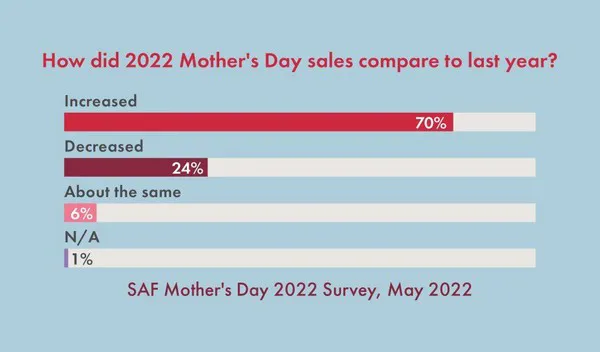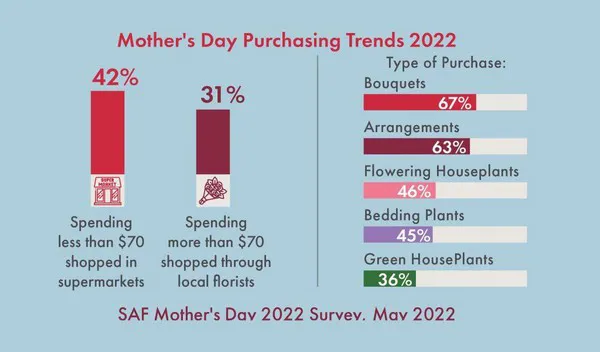It’s always great news when we see strong sales during a holiday, despite all the challenges. And Mother’s Day continues that streak of blossoming sales! In SAF’s most recent survey, 62 percent of respondents reported an increase in sales from 2021, and 50 percent reported an increase in the number of units sold. And Ipsos, a global market research firm, said that nearly a third of Americans purchased flowers for Mother’s Day this year, in line with past years. These numbers aren’t just good news; they also show the power of flowers to bring joy to others.
Where the Sales Increase Came From
When you break down the information from the SAF survey, here’s where retailers say they got their sales increases:
- higher price points and service fees, including higher delivery charges
- less competition from other floral companies
- more time and effort spent on marketing and promotions
Those who reported a sales decrease (23%) stated that they had challenges sourcing product, materials, and supplies. Additionally, they said the economics of their regional economy affected sales, and many of them didn’t have enough staff.

Purchasing Trends: What, Where, and How Much
The SAF survey reported that the most common Mother’s Day flower purchase price range was between $71 and $100. And the Ipsos survey (mentioned above and commissioned by SAF) reported that purchases broke down as follows:
- Those who spent less than $70 (42%) were more likely to shop at supermarkets or grocery stores.
- Those who spent more than $70 were more likely to purchase from an online florist (40%) or a local retail floral shop (31%).
- 67% of purchasers bought bouquets, 63% arrangements, 46% flowering houseplants, 45% outdoor bedding plants or containers, and 36% green houseplants.
- The largest flower-purchasing demographic for Mother’s Day was 18- to 34-year-olds (48%). And households with children were more than twice as likely to purchase flowers than those without children (49% vs. 23%).

Other Spring Holiday Floral Sales
The SAF survey also asked respondents about other spring holidays: Easter, Passover, and Administrative Professionals’ Week. 45% of retailers reported an increase in Easter and Passover sales, with 29% reporting a decrease. And as to units sold, 41% reported an increase and 39% a decrease.
Administrative Professionals’ Week, on the other hand, was not as strong. Almost 38% of respondents reported a decline in sales from last year, with 42% reporting a decrease in units sold. So many companies are still operating remotely or in a hybrid situation, which may account for the reduction in sales.
For more information
Rio Roses
www.rioroses.com
